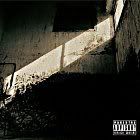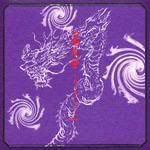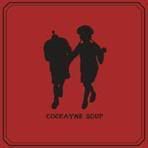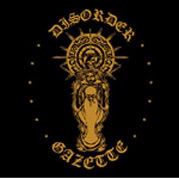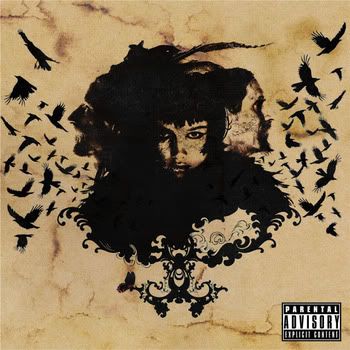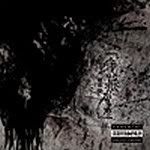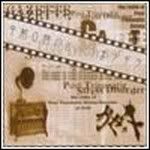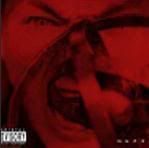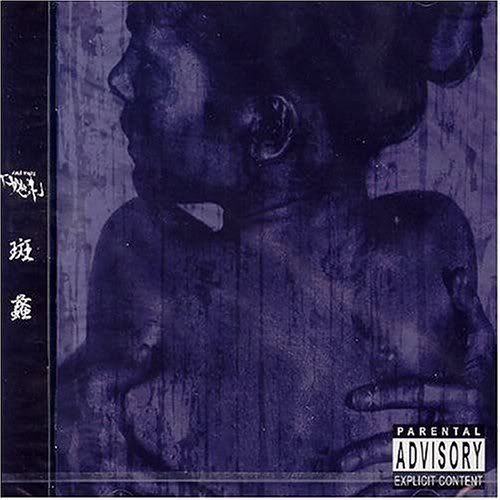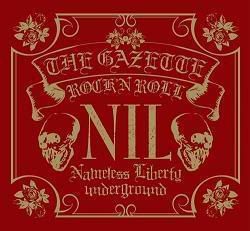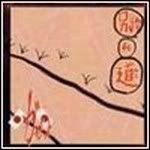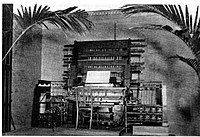Electronic music is music that employs electronic musical instruments and electronic music technology in its production. In general a distinction can be made between sound produced using electromechanical means and that produced using electronic technology.Examples of electromechanical sound producing devices include the telharmonium, Hammond organ, and the electric guitar. Purely electronic sound production can be achieved using devices such as the Theremin, sound synthesizer, and computer.
Electronic music was once associated almost exclusively with Western art music but from the late 1960s on the availability of affordable music technology meant that music produced using electronic means became increasingly common in the popular domain. Today electronic music includes many varieties and ranges from experimental art music to popular forms such as electronic dance music.
History
Late 19th century to early 20th century
The ability to record sounds is often connected to the production of electronic music, but not absolutely necessary for it. The earliest known sound recording device was the phonautograph, patented in 1857 by Édouard-Léon Scott de Martinville. It could record sounds visually, but was not meant to play them back.
In 1878, Thomas A. Edison patented the phonograph, which used cylinders similar to Scott's device. Although cylinders continued in use for some time, Emile Berliner developed the disc phonograph in 1887.
A significant invention, which was later to have a profound effect on electronic music, was Lee DeForest's triode audion. This was the first thermionic valve, or vacuum tube, invented in 1906, which led to the generation and amplification of electrical signals, radio broadcasting, and electronic computation, amongst other things.
Before electronic music, there was a growing desire for composers to use emerging technologies for musical purposes. Several instruments were created that employed electromechanical designs and they paved the way for the later emergence of electronic instruments. An electromechanical instrument called the Teleharmonium (or Telharmonium) was developed by Thaddeus Cahill in the years 1898-1912. However, simple inconvenience hindered the adoption of the Teleharmonium, due to its immense size. The first electronic instrument is often viewed to be the Theremin, invented by Professor Leon Theremin circa 1919–1920. Another early electronic instrument was the Ondes Martenot, which was most famously used in the Turangalîla-Symphonie by Olivier Messiaen as well as other works by him. It was also used by other, primarily French, composers such as Andre Jolivet.[citation needed]
[edit] "New Aesthetic of Music"
-
Just a year later, another significant contribution was made to the advent of experimental music. This was the 1907 publication of Ferruccio Busoni's Sketch of a New Esthetic of Music, which discussed the use of electrical and other new sound sources in future music. He wrote of the future of microtonal scales in music, made possible by Cahill's Dynamophone:
Only a long and careful series of experiments, and a continued training of the ear, can render this unfamiliar material approachable and plastic for the coming generation, and for Art.
Also in the Sketch of a New Esthetic of Music, Busoni states:
Music as an art, our so-called occidental music, is hardly four hundred years old; its state is one of development, perhaps the very first stage of a development beyond present conception, and we—we talk of "classics" and "hallowed traditions"! And we have talked of them for a long time! We have formulated rules, stated principles, laid down laws;—we apply laws made for maturity to a child that knows nothing of responsibility! Young as it is, this child, we already recognize that it possesses one radiant attribute which signalizes it beyond all its elder sisters. And the lawgivers will not see this marvelous attribute, lest their laws should be thrown to the winds. This child—it floats on air! It touches not the earth with its feet. It knows no law of gravitation. It is wellnigh incorporeal. Its material is transparent. It is sonorous air. It is almost Nature herself. It is—free! But freedom is something that mankind have never wholly comprehended, never realized to the full. They can neither recognize nor acknowledge it. They disavow the mission of this child; they hang weights upon it. This buoyant creature must walk decently, like anybody else. It may scarcely be allowed to leap—when it were its joy to follow the line of the rainbow, and to break sunbeams with the clouds.
Through this writing, as well as personal contact, Busoni had a profound effect on many musicians and composers, perhaps most notably on his pupil, Edgard Varèse, who said:
Together we used to discuss what direction the music of the future would, or rather, should take and could not take as long as the straitjacket of the tempered system. He deplored that his own keyboard instrument had conditioned our ears to accept only an infinitesimal part of the infinite gradations of sounds in nature. He was very much interested in the electrical instruments we began to hear about, and I remember particularly one he had read of called the Dynamophone. All through his writings one finds over and over again predictions about the music of the future which have since come true. In fact, there is hardly a development that he did not foresee, as for instance in this extraordinary prophecy: 'I almost think that in the new great music, machines will also be necessary and will be assigned a share in it. Perhaps industry, too, will bring forth her share in the artistic ascent.
The Futurists
-

Luigi Russolo with his assistant Ugo Piatti and their Intonarumori (noise machines)
In Italy, the Futurists were coming at the changing aesthetic from a different angle, but one that also affected the world of classical music. A major thrust of the Futurist philosophy was to value "noise," and to place artistic and expressive value on sounds that had previously not been considered even remotely musical. Balilla Pratella's "Technical Manifesto of Futurist Music" (1911) states that their credo is:
To present the musical soul of the masses, of the great factories, of the railways, of the transatlantic liners, of the battleships, of the automobiles and airplanes. To add to the great central themes of the musical poem the domain of the machine and the victorious kingdom of Electricity.|
In 1914, futurist Luigi Russolo held the first "art-of-noises" concert in Milan on April 21. This used his Intonarumori, described by Russolo as "acoustical noise-instruments, whose sounds (howls, roars, shuffles, gurgles, etc.) were hand-activated and projected by horns and megaphones." In June, similar concerts were held in Paris.
The 1920–1930s
This decade brought a wealth of early electronic instruments. Along with the Theremin, there is the presentation of the Ondes Martenot, which was designed to reproduce the microtonal sounds found in Hindu music,[citation needed] and the Trautonium. Maurice Martenot invented the Ondes Martenot in 1928, and soon demonstrated it in Paris.
Another development, which aroused the interest of many composers, occurred in 1919–1920. In Leningrad, Leon Theremin (actually Lev Termen) built and demonstrated his Etherophone, which was later renamed the Theremin. This led to the first compositions for electronic instruments, as opposed to noisemakers and re-purposed machines. In 1929, Joseph Schillinger composed First Airphonic Suite for Theremin and Orchestra, premièred with the Cleveland Orchestra with Leon Theremin as soloist.
In 1924, Ottorino Respighi composed The Pines of Rome, which calls for the use of a phonograph recording of nightingales. However, at the time of composition, phonograph players were acoustical, not electric, and this is actually more along the lines of using a sound effect, and therefore cannot be considered an electroacoustic element in the composition.
The following year, Antheil first composed for mechanical devices, electrical noisemakers, motors and amplifiers in his unfinished opera, Mr. Bloom, as a response to the "art of noises" of Luigi Russolo, Marinetti and the other Futurists.[citation needed] And just one year later in 1926, was the première of Antheil's Ballet Mécanique, using car horns, airplane propellers, saws, and anvils (but no electronics).
Recording of sounds made a leap in 1927, when American inventor J. A. O'Neill developed a recording device that used magnetically coated ribbon. However, this was a commercial failure. Two years later, Laurens Hammond established his company for the manufacture of electronic instruments. He went on to produce the Hammond organ, which was based on the principles of the Telharmonium, along with other developments including early reverberation units.
The method of photo-optic sound recording used in cinematography made it possible to obtain a visible image of a sound wave, as well as to realize the opposite goal—synthesizing a sound from an artificially drawn sound wave. The research work by the Russian optical engineer Evgeny Murzin[citation needed] taken from 1937 to 1957[citation needed] made it possible to create a photoelectric synthesizer—a musical instrument that combined three processes: creation, recording, and playback of music. Murzin named his invention in honour of the composer Alexander Nikolayevich Scriabin (“ANS”).[citation needed]
Developments from 1945 to 1960
Musique concrète
-
- See also: Acousmatic music
The tape recorder had been developed in Germany during the early 1930s. Whereas Wire recorders had been in use since 1898, the first practical tape recorder was called the Magnetophon (Angus 1984.)[citation needed] It wasn't long before composers used the tape recorder to develop a new technique for composition called Musique concrète. This technique involved editing together recorded fragments of natural and industrial sounds.[The first pieces of musique concrète were written by Pierre Schaeffer, who later worked together with Pierre Henry.
On 5 October 1948, Radiodiffusion Française (RDF) broadcast composer Pierre Schaeffer's Etude aux chemins de fer. This was the first "movement" of Cinq études de bruits, and marked the beginning of studio realizations and musique concrète (or acousmatic music). Schaeffer employed a disk-cutting lathe, four turntables, a four-channel mixer, filters, an echo chamber, and a mobile recording unit.
Not long after this, Pierre Henry began collaborating with Schaeffer, a collaboration that was to have profound and lasting affects on the progression of electronic music. Also associated with Schaeffer, Edgard Varèse began work on Déserts for chamber orchestra and tape. The tape parts were created at Pierre Schaeffer's studio, and were later revised at Columbia University.
In 1950, Schaeffer gave the first public (non-broadcast) concert of musique concrète at the Ecole Normale de Musique de Paris. "Schaeffer used a PA system, several turntables, and mixers. The performance did not go well, as creating live montages with turntables had never been done before." Later that same year, Pierre Henry collaborated with Schaeffer on Symphonie pour un homme seul (1950) the first major work of musique concrete. In Paris in 1951, in what was to become an important worldwide trend, RTF established the first studio for the production of electronic music. Also in 1951, Schaeffer and Henry produced an opera, Orpheus, for concrete sounds and voices.
Elektronische Musik
Karlheinz Stockhausen worked briefly in Schaeffer's studio in 1952, and afterward for many years at the WDR Cologne's Studio for Electronic Music.
In Cologne, what would become the most famous electronic music studio in the world was officially opened at the radio studios of the NWDR in 1953, though it had been in the planning stages as early as 1950 and early compositions were made and broadcast in 1951.[17][citation needed] The brain child of Werner Meyer-Eppler, Robert Beyer, and Herbert Eimert (who became its first director), the studio was soon joined by Karlheinz Stockhausen and Gottfried Michael Koenig. Meyer-Eppler's conception was to synthesize music entirely from electronically produced signals; in this way, elektronische Musik was sharply differentiated from French musique concrète, which used sounds recorded from acoustical sources.[citation needed]
With Stockhausen and Mauricio Kagel in residence, it became a year-round hive of charismatic avante-gardism [sic]" on two occasions combining electronically generated sounds with relatively conventional orchestras—in Mixtur (1964) and Hymnen, dritte Region mit Orchester (1967).Stockhausen stated that his listeners had told him his electronic music gave them an experience of "outer space," sensations of flying, or being in a "fantastic dream world" More recently, Stockhausen turned to producing electronic music in his own studio in Kürten, his last work in the genre being Cosmic Pulses (2007).
American electronic music
In the United States, sounds were being created electronically and used in composition, as exemplified in a piece by Morton Feldman called Marginal Intersection. This piece is scored for winds, brass, percussion, strings, 2 oscillators, and sound effects of riveting, and the score uses Feldman's graph notation.
The Music for Magnetic Tape Project was formed by members of the New York School (John Cage, Earle Brown, Christian Wolff, David Tudor, and Morton Feldman), and lasted three years until 1954. Cage wrote of this collaboration,
In this social darkness, therefore, the work of Earle Brown, Morton Feldman, and Christian Wolff continues to present a brilliant light, for the reason that at the several points of notation, performance, and audition, action is provocative.|
Cage completed Williams Mix in 1953 while working with the Music for Magnetic Tape Project. The group had no permanent facility, and had to rely on borrowed time in commercial sound studios, including the studio of Louis and Bebe Barron.
Columbia-Princeton
-
Also in the U.S., in the same year, significant developments were happening in New York City. Columbia University purchased its first tape recorder—a professional Ampex machine—for the purpose of recording concerts.
Vladimir Ussachevsky, who was on the music faculty of Columbia University, was placed in charge of the device, and almost immediately began experimenting with it.
Herbert Russcol writes: "Soon he was intrigued with the new sonorities he could achieve by recording musical instruments and then superimposing them on one another."
Ussachevsky said later: "I suddenly realized that the tape recorder could be treated as an instrument of sound transformation."[citation needed]
On Thursday, May 8, 1952, Ussachevsky presented several demonstrations of tape music/effects that he created at his Composers Forum, in the McMillin Theatre at Columbia University. These included Transposition, Reverberation, Experiment, Composition, and Underwater Valse. In an interview, he stated: "I presented a few examples of my discovery in a public concert in New York together with other compositions I had written for conventional instruments." Otto Luening, who had attended this concert, remarked: "The equipment at his disposal consisted of an Ampex tape recorder . . . and a simple box-like device designed by the brilliant young engineer, Peter Mauzey, to create feedback, a form of mechanical reverberation. Other equipment was borrowed or purchased with personal funds."
Just three months later, in August 1952, Ussachevsky traveled to Bennington, Vermont at Luening's invitation to present his experiments. There, the two collaborated on various pieces. Luening described the event: "Equipped with earphones and a flute, I began developing my first tape-recorder composition. Both of us were fluent improvisors and the medium fired our imaginations." They played some early pieces informally at a party, where "a number of composers almost solemnly congratulated us saying, 'This is it' ('it' meaning the music of the future)."
Word quickly reached New York City. Oliver Daniel telephoned and invited the pair to "produce a group of short compositions for the October concert sponsored by the American Composers Alliance and Broadcast Music, Inc., under the direction of Leopold Stokowski at the Museum of Modern Art in New York. After some hesitation, we agreed. . . . Henry Cowell placed his home and studio in Woodstock, New York, at our disposal. With the borrowed equipment in the back of Ussachevsky's car, we left Bennington for Woodstock and stayed two weeks. . . . In late September, 1952, the travelling laboratory reached Ussachevsky's living room in New York, where we eventually completed the compositions."
Two months later, on October 28, Vladimir Ussachevsky and Otto Luening presented the first Tape Music concert in the United States. The concert included Luening's Fantasy in Space (1952)—"an impressionistic virtuoso piece" using manipulated recordings of flute—and Low Speed (1952), an "exotic composition that took the flute far below its natural range." Both pieces were created at the home of Henry Cowell in Woodstock, NY. After several concerts caused a sensation in New York City, Ussachevsky and Luening were invited onto a live broadcast of NBC's Today Show to do an interview demonstration—the first televised electroacoustic performance. Luening described the event: "I improvised some [flute] sequences for the tape recorder. Ussachevsky then and there put them through electronic transformations."
1954 saw the advent of what would now be considered authentic electric plus acoustic compositions—acoustic instrumentation augmented/accompanied by recordings of manipulated and/or electronically generated sound. Three major works were premiered that year: Varèse's Déserts, for chamber ensemble and tape sounds, and two works by Luening and Ussachevsky: Rhapsodic Variations for the Louisville Symphony and A Poem in Cycles and Bells, both for orchestra and tape. Because he had been working at Schaeffer's studio, the tape part for Varèse's work contains much more concrete sounds than electronic. "A group made up of wind instruments, percussion and piano alternates with mutated sounds of factory noises and ship sirens and motors, coming from two loudspeakers."
Déserts was premiered in Paris in the first stereo broadcast on French Radio. At the German premiere in Hamburg, which was conducted by Bruno Maderna, the tape controls were operated by Karlheinz Stockhausen. The title Déserts, suggested to Varèse not only, "all physical deserts (of sand, sea, snow, of outer space, of empty streets), but also the deserts in the mind of man; not only those stripped aspects of nature that suggest bareness, aloofness, timelessness, but also that remote inner space no telescope can reach, where man is alone, a world of mystery and essential loneliness."
Stochastic music
-
An important new development was the advent of computers for the purpose of composing music, as opposed to manipulating or creating sounds. Iannis Xenakis began what is called "musique stochastique," or "stochastic music," which is a method of composing that employs mathematical probability systems. Different probability algorithms were used to create a piece under a set of parameters. Xenakis used graph paper and a ruler to aid in calculating the velocity trajectories of glissandi for his orchestral composition Metastasis (1953–54), but later turned to the use of computers to compose pieces like ST/4 for string quartet and ST/48 for orchestra (both 1962).
Mid to late 1950s
In 1954, Stockhausen composed his Elektronische Studie II—the first electronic piece to be published as a score.
In 1955, more experimental and electronic studios began to appear. Notable were the creation of the Studio de Fonologia (already mentioned), a studio at the NHK in Tokyo founded by Toshiro Mayuzumi, and the Phillips studio at Eindhoven, the Netherlands, which moved to the University of Utrecht as the Institute of Sonology in 1960.
The score for Forbidden Planet, by Louis and Bebe Barron, was entirely composed using custom built electronic circuits in 1956.
The impact of computers continued in 1956. Lejaren Hiller and Leonard Isaacson composed Iliac Suite for string quartet, the first complete work of computer-assisted composition using algorithmic composition. "... Hiller postulated that a computer could be taught the rules of a particular style and then called on to compose accordingly."
That same year Stockhausen composed Gesang der Jünglinge, the first major work of the Cologne studio, based on a text from the Book of Daniel. An important technological development of that year was the invention of the Clavivox synthesizer by Raymond Scott with subassembly by Robert Moog.
Two new electronic instruments made their debut in 1957. Unlike the earlier Theremin and Ondes Martenot, these instruments were hard to use, required extensive programming, and neither could be played in real time. The first of these electronic instruments was the computer when Max Mathews used a program called Music 1, later users were Edgard Varèse, and Iannis Xenakis. The other electronic instrument that appeared that year was the first electronic synthesizer. Called the RCA Mark II Sound Synthesizer, it used vacuum tube oscillators and incorporated the first electronic music sequencer. It was designed by RCA and installed at the Columbia-Princeton Electronic Music Center where it remains to this day.[citation needed]
In 1957, MUSIC, one of the first computer programs to play electronic music, was created by Max Mathews at Bell Laboratories.
Later, Milton Babbitt, influenced in his student years by Schoenberg's "revolution in musical thought" began applying serial techniques to electronic music.
From 1950 to 1960 the vocabulary of tape music shifted from the fairly pure experimental works which characterized the classic Paris and Cologne schools to more complex and expressive works which explored a wide range of compositional styles. More and more works began to appear by the mid-1950s which addressed the concept of combining taped sounds with live instruments and voices. There was also a tentative interest, and a few attempts, at incorporating taped electronic sounds into theatrical works.
The public remained interested in the new sounds being created around the world, as can be deduced by the inclusion of Varèse's Poeme Electronique, which was played over four hundred loudspeakers at the Phillips Pavilion of the 1958 Brussels World Fair. That same year, Mauricio Kagel, an Argentine composer, composed Transición II, the first piece to call for live tape recorder as part of performance.[citation needed] The work was realized at the WDR studio in Cologne. Two musicians perform on a piano, one in the traditional manner, the other playing on the strings, frame, and case. Two other performers use tape to unite the presentation of live sounds with the future of prerecorded materials from later on and its past of recordings made earlier in the performance.
The 1960s
These were fertile years for electronic music—not for academia, and for independent artists as synthesizer technology became more accessible. By this time, a strong community of composers and musicians working with new sounds and instruments was well established, and growing. 1960 witnessed the composition of Luening's Gargoyles for violin and tape as well as the premiere of Stockhausen's Kontakte for electronic sounds, piano, and percussion. This piece existed in two versions—one for 4-channel tape, and the other for tape with human performers. "In Kontakte, Stockhausen abandoned traditional musical form based on linear development and dramatic climax. This new approach, which he termed 'moment form,' resembles the 'cinematic splice' techniques in early twentieth century film."
The first of these synthesizers to appear was the Buchla. Appearing in 1963, it was the product of an effort spearheaded by musique concrète composer Morton Subotnick. In 1962, working with a grant from the Rockefeller Foundation, Subotnick and business partner Ramon Sender hired electrical engineer Don Buchla to build a "black box" for composition.[citation needed]
The theremin, an exceedingly difficult instrument to play, was even used in some popular music.[citation needed]
One influential pioneer and artist in this period was Delia Derbyshire of the BBC Radiophonic Workshop, who added a keen musical ear to mere technological prowess.
Milton Babbitt composed his first electronic work using the synthesizer—his Composition for Synthesizer—which he created using the RCA synthesizer at CPEMC.
For Babbitt, the RCA synthesizer was a dream come true for three reasons. First, the ability to pinpoint and control every musical element precisely. Second, the time needed to realize his elaborate serial structures were brought within practical reach. Third, the question was no longer "What are the limits of the human performer?" but rather "What are the limits of human hearing?
The collaborations also occurred across oceans and continents. In 1961, Ussachevsky invited Varèse to the Columbia-Princeton Studio (CPEMC). Upon arrival, Varese embarked upon a revision of Déserts. He was assisted by Mario Davidovsky and Bülent Arel.[35]
The intense activity occurring at CPEMC and elsewhere inspired the establishment of the San Francisco Tape Music Center in 1963 by Morton Subotnick, with additional members Pauline Oliveros, Ramon Sender, Terry Riley, and Anthony Martin. The center soon incorporated a voltage-controlled synthesizer based around automated sequencing by Don Buchla, and used in album-length Subotnick pieces such as Silver Apples of the Moon (1967) and The Wild Bull (1968).
Later, the Center moved to Mills College, directed by Pauline Oliveros, where it is today known as the Center for Contemporary Music.
Back across the Atlantic, in Czechoslovakia, 1964, the First Seminar of Electronic Music was held at the Radio Broadcast Station in Plzen. Four government-sanctioned electroacoustic music studios were later established in the 1960s under the auspices of extant radio and television stations.
New instruments continued to develop. In 1964, the first fully-developed Moog synthesizer was completed.
Moog Music introduced a smaller synthesizer with a built-in keyboard and hardwired signal path called The Minimoog, which was introduced to many composers, universities and popular musicians.
A well-known example of the use of Moog's full-sized Moog Modular synthesizer is the Switched-On Bach album by Wendy Carlos. This decade saw construction of more than 50 electronic music studios in the USA, mostly in universities.
Computer music
-
Main article: Computer music - See also: Music-N and Algorithmic composition
One of the first major public demonstrations of computer music was a pre-recorded national radio broadcast on the NBC radio network program Monitor on February 10, 1962. In 1961, LaFarr Stuart programmed Iowa State University's CYCLONE computer (a derivative of the Illiac) to play simple, recognizable tunes through an amplified speaker that had been attached to the system originally for administrative and diagnostic purposes. An interview with Mr. Stuart accompanied his computer music.
The 1960s also saw the development of large mainframe computer synthesis. Max Mathews of Bell Labs perfected MUSIC V, a direct digital synthesis language.
[edit] Live electronics
- See also: electroacoustic improvisation
In America, live electronics were pioneered in the early 1960s by members of Milton Cohen's Space Theater in Ann Arbor, Michigan, including Gordon Mumma and Robert Ashley, by individuals such as David Tudor around 1965, and The Sonic Arts Union, founded in 1966 by Gordon Mumma, Robert Ashley, Alvin Lucier, and David Behrman. ONCE Festivals, featuring multimedia theater music, were organized by Robert Ashley and Gordon Mumma in Ann Arbor between 1958 and 1969. In 1960, John Cage composed Cartridge Music, one of the earliest live-electronic works.
In Europe in 1964, Karlheinz Stockhausen composed Mikrophonie I for tam-tam, hand-held microphones, filters, and potentiometers, and Mixtur for orchestra, for four sine-wave generators, and four ring modulators. In 1965 he composed Mikrophonie II for choir, Hammond organ, and ring modulators.
In 1966-67 Reed Ghazala discovered and began to teach "circuit bending"—the application of the creative short circuit, a process of chance short-circuiting, creating experimental electronic instruments, exploring sonic elements mainly of timbre and with less regard to pitch or rhythm, and influenced by John Cage’s aleatoric music concept.
1970s
In 1970, Charles Wuorinen composed Time's Encomium, the first Pulitzer Prize winner for an entirely electronic composition
Affordable synthesisers
- See also: Minimoog, Modular synthesizer, Buchla, ARP Instruments, Inc., and Korg
Released in 1970 by Moog Music the Mini-Moog was among the first widely available, portable and relatively affordable synthesizers. It became the most widely used synthesizer in both popular and electronic art music.
IRCAM
-
(Paris) became a major center for computer music research and realization and development of the Sogitec 4X computer system, featuring then revolutionary real-time digital signal processing. Pierre Boulez's Repons (1981) for 24 musicians and 6 soloists used the 4X to transform and route soloists to a loudspeaker system.
Rise of popular electronic music
- See also: Kraftwerk, Krautrock, Space rock, Synthpop, New Order, Depeche Mode, Human League, and Ultravox
Throughout the seventies bands such as The Residents and Can spearheaded an experimental music movement that incorporated electronic sounds. Can were one of the first bands to use tape loops for rhythm sections and The Residents created their own custom built drum machine.
In 1979, UK recording artist Gary Numan helped to bring electronic music into the wider marketplace of pop music with his hit "Cars" from the album The Pleasure Principle. Arguably[weasel words] the biggest hit single of the 80s "Blue Monday" by New Order released in 1983 from the "Power, Corruption and Lies" album solidified electronic music in the mainstream for good and paved the way for today's modern electronic music.[citation needed] Other influential artists in the 1970s and early 80s, who composed primarily electronic instrumental music and managed to reach beyond the academic sphere and into the popular realm, were Jean Michel Jarre, Tangerine Dream, Klaus Schulze, Vangelis, Yello, Ray Buttigieg and Art of Noise.
1980s
[edit] Birth of MIDI
-
In 1980, a group of musicians and music merchants met to standardize an interface by which new instruments could communicate control instructions with other instruments and the prevalent microcomputer. This standard was dubbed MIDI (Musical Instrument Digital Interface). A paper was authored by Dave Smith of Sequential Circuits and proposed to the Audio Engineering Society in 1981. Then, in August 1983, the MIDI Specification 1.0 was finalized.
The advent of MIDI technology allows a single keystroke, control wheel motion, pedal movement, or command from a microcomputer to activate every device in the studio remotely and in synchrony, with each device responding according to conditions predetermined by the composer.
MIDI instruments and software made powerful control of sophisticated instruments easily affordable by many studios and individuals. Acoustic sounds became reintegrated into studios via sampling and sampled-ROM-based instruments.
Miller Puckette developed graphic signal-processing software for 4X called Max (after Max Mathews) and later ported it to Macintosh (with Dave Zicarelli extending it for Opcode [41]) for real-time MIDI control, bringing algorithmic composition availability to most composers with modest computer programming background.
Affordable digital synthesis
- See also: Digital synthesizer and Sampling (music)
In 1983, Yamaha introduced the first stand-alone digital synthesizer, the DX-7. It used frequency modulation synthesis (FM synthesis), first experimented with by John Chowning at Stanford during the late sixties.
Barry Vercoe describes one of his experiences with early computer sounds:
At IRCAM in Paris in 1982, flutist Larry Beauregard had connected his flute to DiGiugno's 4X audio processor, enabling real-time pitch-following. On a Guggenheim at the time, I extended this concept to real-time score-following with automatic synchronized accompaniment, and over the next two years Larry and I gave numerous demonstrations of the computer as a chamber musician, playing Handel flute sonatas, Boulez's Sonatine for flute and piano and by 1984 my own Synapse II for flute and computer—the first piece ever composed expressly for such a setup. A major challenge was finding the right software constructs to support highly sensitive and responsive accompaniment. All of this was pre-MIDI, but the results were impressive even though heavy doses of tempo rubato would continually surprise my Synthetic Performer. In 1985 we solved the tempo rubato problem by incorporating learning from rehearsals (each time you played this way the machine would get better). We were also now tracking violin, since our brilliant, young flutist had contracted a fatal cancer. Moreover, this version used a new standard called MIDI, and here I was ably assisted by former student Miller Puckette, whose initial concepts for this task he later expanded into a program called MAX.
Rise of electronic dance music
-
- See also: Italo disco, Euro disco, New romantic, Electro music, Techno, House music, Acid house, and Rave music
1990s
Advancements
In the 1990s, interactive computer-assisted performance started to become possible, with one example describes as follows:
Automated Harmonization of Melody in Real Time: An interactive computer system, developed in collaboration with flutist/composer Pedro Eustache, for realtime melodic analysis and harmonic accompaniment. Based on a novel scheme of harmonization devised by Eustache, the software analyzes the tonal melodic function of incoming notes, and instantaneously performs an orchestrated harmonization of the melody. The software was originally designed for performance by Eustache on Yamaha WX7 wind controller, and was used in his composition Tetelestai, premiered in Irvine, California in March 1999.
Other recent developments included the Tod Machover (MIT and IRCAM) composition Begin Again Again for "hypercello," an interactive system of sensors measuring physical movements of the cellist. Max Mathews developed the "Conductor" program for real-time tempo, dynamic and timbre control of a pre-input electronic score. Morton Subotnick released a multimedia CD-ROM All My Hummingbirds Have Alibis.
Growth of popular electronic music

A live performance with electronic instruments.
- See also: Intelligent dance music, electronica, and List of electronic music genres
The 2000s
In recent years, as computer technology has become more accessible and music software has advanced, interacting with music production technology is now possible using means that bear no relationship to traditional musical performance practices: for instance, laptop performance (laptronica)and live coding.
In the last decade a number of software-based virtual studio environments have emerged, with products such as Propellerhead's Reason and Ableton Live finding popular appeal.Such tools provide viable and cost-effective alternatives to typical hardware-based production studios, and thanks to advances in microprocessor technology, it is now possible to create high quality music using little more than a single laptop computer. Such advances have, for better or for worse, democratized music creation, leading to a massive increase in the amount of home-produced electronic music available to the general public via the internet.
Artists can now also individuate their production practice by creating personalized software synthesizers, effects modules, and various composition environments. Devices that once existed exclusively in the hardware domain can easily have virtual counterparts. Some of the more popular software tools for achieving such ends are commercial releases such as Max/Msp and Reaktor and freeware packages such as Pure Data, SuperCollider, and ChucK.
Circuit Bending

Probing for "bends" using a jeweler's screwdriver and alligator clips.
-
A practice originally pioneered by Reed Ghazala in the 1960s; it has recently found significant popular appeal. Circuit bending is the creative short-circuiting of low voltage, battery-powered electronic audio devices such as guitar effects, children's toys and small synthesizers to create new musical instruments and sound generators.[citation needed] Emphasizing spontaneity and randomness, the techniques of circuit bending have been commonly associated with noise music, though many more conventional contemporary musicians and musical groups have been known to experiment with "bent" instruments.[citation needed]

 COLLECTION (2008.09.03)[ Album ]
COLLECTION (2008.09.03)[ Album ] 1 Metronome (02.04.2003)[ Album ]
1 Metronome (02.04.2003)[ Album ] Computer (21.10.2004)[ Maxi-Single ]
Computer (21.10.2004)[ Maxi-Single ] Cycle recycle (31.01.2007)[ Mini-Album ]
Cycle recycle (31.01.2007)[ Mini-Album ] Electric Travel (05.10.2005)[ Mini-Album ]
Electric Travel (05.10.2005)[ Mini-Album ] Fukigen na ANDROID (11.01.2002)[ Maxi-Single ]
Fukigen na ANDROID (11.01.2002)[ Maxi-Single ]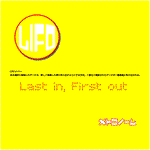 LIFO (17.11.2004)[ Mini-Album ]
LIFO (17.11.2004)[ Mini-Album ]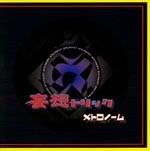 mousou trick (01.02.2004)[ Maxi-Single ]
mousou trick (01.02.2004)[ Maxi-Single ] Planet (31.07.2002)[ Maxi-Single ]
Planet (31.07.2002)[ Maxi-Single ]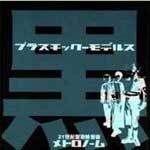 PLASTIC MODELS kuro (31.07.2001)[ Maxi-Single ]
PLASTIC MODELS kuro (31.07.2001)[ Maxi-Single ]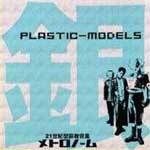 PLASTIC MODELS gin (31.07.2001)[ Maxi-Single ]
PLASTIC MODELS gin (31.07.2001)[ Maxi-Single ] Self-Control (14.09.2002)[ Maxi-Single ]
Self-Control (14.09.2002)[ Maxi-Single ] S.P.A.C.E! Romantic (03.09.2003)[ Single ]
S.P.A.C.E! Romantic (03.09.2003)[ Single ] Tawainai Twilight (08.08.2007)[ Maxi-Single ]
Tawainai Twilight (08.08.2007)[ Maxi-Single ]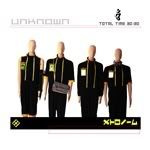 UNKNOWN (21.04.2004)[ Mini-Album ]
UNKNOWN (21.04.2004)[ Mini-Album ]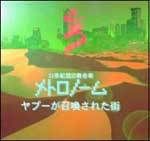 YAPUU no shoukansareta machi (09.09.2000)[ Maxi-Single ]
YAPUU no shoukansareta machi (09.09.2000)[ Maxi-Single ] Zombie-kun (26.09.2007)[ Maxi-Single ]
Zombie-kun (26.09.2007)[ Maxi-Single ]







